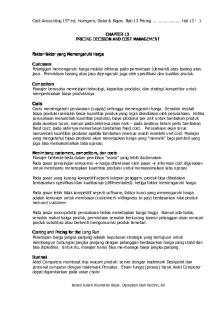Arbitrage Pricing Theory PDF

| Title | Arbitrage Pricing Theory |
|---|---|
| Author | Adrian Orao |
| Course | FINANCIAL AND COST ACCOUNTING I |
| Institution | Management University of Africa |
| Pages | 2 |
| File Size | 72.7 KB |
| File Type | |
| Total Downloads | 76 |
| Total Views | 190 |
Summary
Download Arbitrage Pricing Theory PDF
Description
ARBITRAGE PRICING THEORY (APT) Formulated by Ross(1976), the Arbitrage Pricing Theory(APT) offers a testable alternative to the capital market pricing model(CAPM). The main difference between CAPM and APT is that CAPM assumes that security rates of returns will be linearly related to a single common factorthe rate of return on the market portfolio. The APT is based on similar intuition but is much more general. APT assumes that, in equilibrium, the return on an arbitrage portfolio (i.e. one with zero investment, and zero systematic risk) is zero. If this return is positive, then it would be eliminated immediately through the process of arbitrage trading to improve the expected returns. Ross (1976) demonstrated that when no further arbitrage opportunities exist, the expected return (E(Ri)) can be shown as follows: E(Ri)=Rf + β1(R1-Rf)+β2(R2 -Rf)+--------+ βn(Rn-Rf)+έi Where, E(Ri) is the expected return on the security Rf is the risk free rate Βi is the sensitivity to changes in factor i έi is a random error term. APT and CAPM compared The Arbitrage Pricing Theory (APT) is much more robust than the capital asset pricing model for several reasons: a) The APT makes no assumptions about the empirical distribution of asset returns. CAPM assumes normal distribution. b) The APT makes no strong assumption about individuals’ utility functions (at least nothing stronger than greed and risk aversion). c) The APT allows the equilibrium returns of asset to be dependent on many factors, not just one (the beta). d) The APT yields a statement about the relative pricing of any subset of assets; hence one need not measure the entire universe of assets in order to test the theory. e) There is no special role for the market portfolio in the APT, whereas the CAPM requires that the market portfolio be efficient. f) The APT is easily extended to a multi-period framework. Since APT makes fewer assumptions than CAPM, it may be applicable to a country like Kenya. However, the model does not state the relevant factors. Cho(1984) has, however, shown the security returns are sensitive to the following factors: Unanticipated inflation, Changes in the
expected level of industrial production, Changes in the risk premium on bonds, and Unanticipated changes in the term structure of interest rates Illustration Security returns depend on only three riskfactors-inflation, industrial production and the aggregate degree of risk aversion. The risk free rate is 8%, the required rate of return on a portfolio with unit sensitivity to inflation and zero-sensitivity to other factors is 13.0%, the required rate of return on a portfolio with unit sensitivity to industrial production and zero sensitivity to inflation and other factors is 10% and the required return on a portfolio with unit sensitivity to the degree of risk aversion and zero sensitivity to other factors is 6%. Security i has betas of 0.9 with the inflation portfolio, 1.2 with the industrial production and-0.7 with risk bearing portfolio—(risk aversion) Assume also that required rate of return on the market is 15% and stock i has CAPM beta of 1.1 REQUIRED: Compute security i's required rate of return using a. b.
CAPM APT
Using APT
Ri = 8% + (13% - 8%)0.9 + (10% - 8%)1.2 + (6% - 8%)(-.7) = 16,3%
Using CAPM
Ri
=
RF + (E(RM) - RF)ßi
Ri
=
8% + (15% - 8%)1.1
=
15.7%
LIMITATIONS OF APT APT does not identify the relevant factors that influence returns nor does it indicate how many factors should appear in the model. Important factors are inflation, industrial production, the spread between low and high grade bonds and the term structure of interest rates....
Similar Free PDFs

ARBITRAGE PRICING THEORY (APT
- 6 Pages

Arbitrage Pricing Theory
- 2 Pages

Theory of Factor Pricing
- 24 Pages

Pricing
- 13 Pages

Bond Arbitrage Example
- 1 Pages

Pricing
- 30 Pages

Pricing Strategies
- 22 Pages

Transfer Pricing
- 3 Pages
Popular Institutions
- Tinajero National High School - Annex
- Politeknik Caltex Riau
- Yokohama City University
- SGT University
- University of Al-Qadisiyah
- Divine Word College of Vigan
- Techniek College Rotterdam
- Universidade de Santiago
- Universiti Teknologi MARA Cawangan Johor Kampus Pasir Gudang
- Poltekkes Kemenkes Yogyakarta
- Baguio City National High School
- Colegio san marcos
- preparatoria uno
- Centro de Bachillerato Tecnológico Industrial y de Servicios No. 107
- Dalian Maritime University
- Quang Trung Secondary School
- Colegio Tecnológico en Informática
- Corporación Regional de Educación Superior
- Grupo CEDVA
- Dar Al Uloom University
- Centro de Estudios Preuniversitarios de la Universidad Nacional de Ingeniería
- 上智大学
- Aakash International School, Nuna Majara
- San Felipe Neri Catholic School
- Kang Chiao International School - New Taipei City
- Misamis Occidental National High School
- Institución Educativa Escuela Normal Juan Ladrilleros
- Kolehiyo ng Pantukan
- Batanes State College
- Instituto Continental
- Sekolah Menengah Kejuruan Kesehatan Kaltara (Tarakan)
- Colegio de La Inmaculada Concepcion - Cebu







